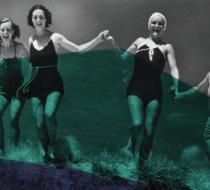"Las sinsombrero": Bare heads against the tyranny of being respectable. Favorite
"Las sinsombrero" ("without hat") were a group of spanish women formed by the artists Maruja Mallo, Margarita Manso, Concha Méndez and the socialist activist Margarita Nelken. During the 20s they were part of Madrid's artistic and intellectual scene, and they gained their name and popularity as a group because they refused to wear a hat in public, something that in that time was a rule of respectability in terms of class and gender. Their attitude somehow reflected the claims and demands of spanish sufragism and early feminism. A few years later, during the 30s, their performances became a movement, the "sinsombrerismo", which received a lot of backlash and was accused of destroying the spanish hat industry.
Walking bare head out on the streets of Madrid was, in that moment, a very transgressive statement, and it had consequences. For example, one time Maruja Mallo and Margarita Manso had stones thrown at them while walking with Salvador Dalí and Federico García Lorca, and they had to run to the subway to protect themselves. In order to avoid situations like this one, Maruja Mallo came up with another performance: they would wear a small balloon tied to their wirst, and said balloon would wear a hat.
However, this was not the only way they challenged gender rules: Concha Méndez would dress herself in work clothes (blue overalls), and Margarita Manso and Maruja Mallo dressed themselves in men clothes borrowed from Salvador Dalí and Federico García Lorca to be able to enter the monastry of Santo Domingo de Silos to hear Gregorian Chant.
Asides from their joint activities, the three artists that were part of this group, Maruja Mallo, Margarita Manso and Concha Méndez were pioneers in the participation of women in the spanish art scene. Their participation in these circles is, itself, political, given the rigid gender rules that existed in Spain an that time, but they went beyond that and used their art to generate a change in the spanish collective consciousness.
Maruja Mallo (1902-1995) was a surrealist painter and a member of the Generation of 1927. From 1920 to 1926 she attended the Real Academia de Bellas Artes de San Fernando (San Fernando's Royal Academy of Fine Arts) in Madrid, where she met the artists, writers and intellectuals that conformed the spanish avant-garde art scene.In 1932 she earned a scholarship to travel to Paris, where she met other artists, like Magritte, Ernst, Chirico, Breton or Éluard. She also worked as a teacher during the 30s. After the Spanish Civil War, she lived in Argentina for more than twenty years, returning to Madrid in 1961.
In one of her most famous performances, Maruja Mallo, riding a bike, broke into a church in Arévalo (Ávila), where she worked as a high school teacher. In the context of a spanish small town, this act created a considerable controversy.
Margarita Manso (1908-1960), was a spanish painter that, like Maruja Mallo, attended the Real Academia de las Artes de San Fernando,
Concha Méndez (1898-1986) was a spanish poetess. In her youth she also gained some popularity as a swimmer. Because of her relationship with Luis Buñuel, she became part of the Generation of 1927. Tired of complying to rigid gender roles, she traveled around Erurope and Latin America, where she published some of her work. She returned to Spain in 1935, and supported the Second Spanish Republic during the Civil War. When the conflict finished, she had to leave to France and then to Cuba and Mexico. She never came back to Spain.










